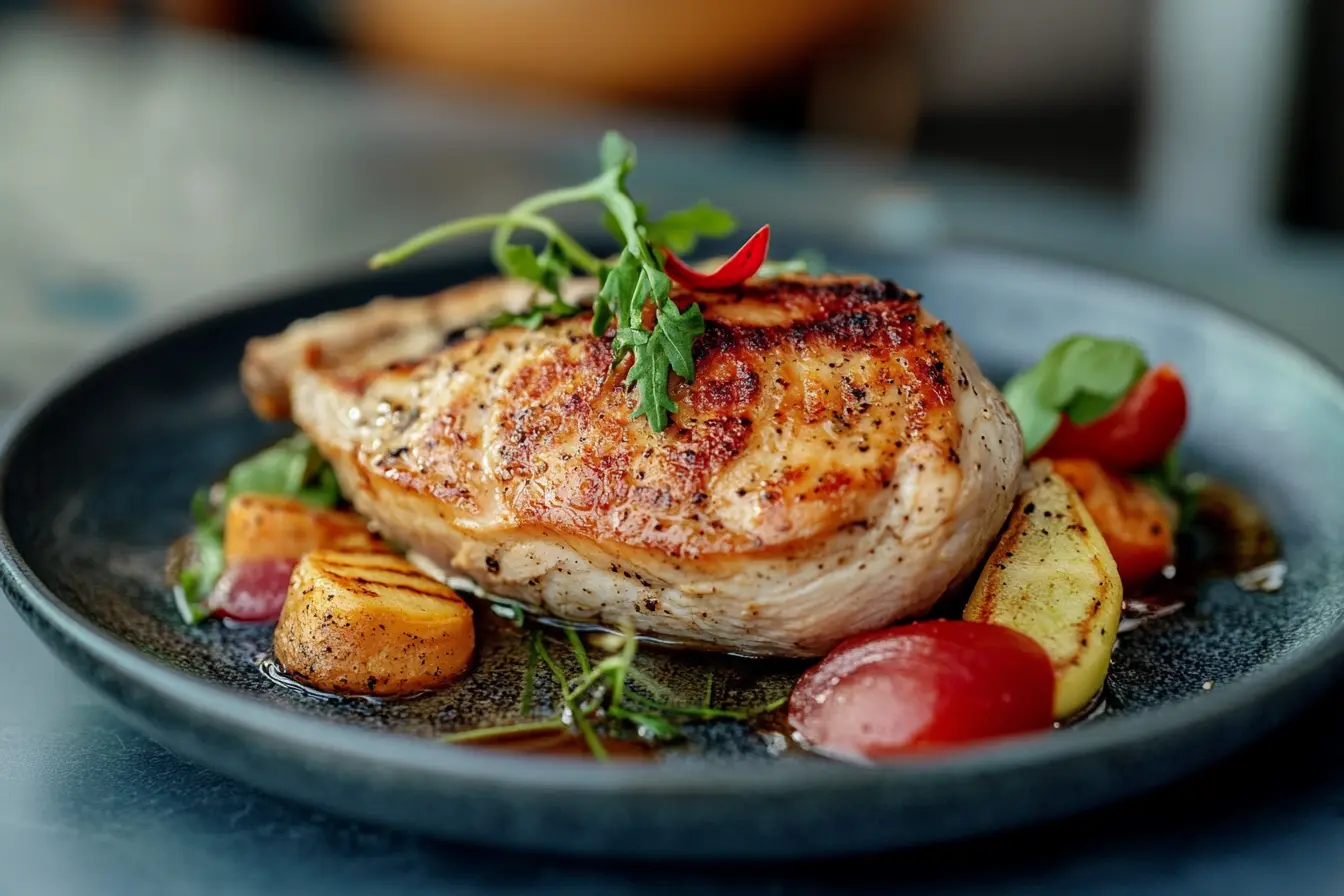Chicken breast can be a culinary delight when cooked correctly. However, this lean meat is notorious for turning dry and flavorless when overcooked or improperly prepared. From understanding the anatomy of chicken breast to mastering cooking techniques that retain its juiciness, this article unravels every tip and trick to help you create moist and tender chicken breasts every time. Let’s dive into the first part of this comprehensive guide.
Understanding Chicken Breast and Its Challenges
Anatomy of Chicken Breast
Chicken breast, often hailed as a healthy protein source, is a lean cut with minimal fat content. Its popularity lies in its versatility and ease of preparation, but this very leanness also makes it prone to drying out. The muscle fibers in chicken breast are delicate, and without proper care during cooking, moisture escapes quickly, leaving behind a tough texture.
The structure of the breast includes muscle and connective tissues, which shrink under heat, expelling natural juices. That’s why paying attention to every step, from thawing to seasoning, is critical to preserving its tenderness.
Common Issues with Cooking Chicken Breast
Dryness and Toughness
One of the most common pitfalls when preparing chicken breast is overcooking. As the internal temperature rises beyond 165°F (74°C), the proteins in the meat contract excessively, squeezing out water content. This is why precise cooking is vital.
Uneven Cooking
Chicken breasts are naturally uneven in thickness, with a thicker portion tapering off into a thinner end. This disparity leads to inconsistent cooking—while the thicker part finishes perfectly, the thinner portion often overcooks and dries out. A straightforward solution to this issue is pounding the breast to a uniform thickness before cooking.
Importance of Moisture in Chicken Breast
Moisture isn’t just about texture—it’s about flavor retention too. A moist chicken breast carries its seasonings and natural flavors better, resulting in a more satisfying bite. Techniques such as brining or marinating help infuse the meat with moisture and enhance its ability to stay juicy, even under heat.
Preparation Techniques for Moist Chicken Breast
Selecting Quality Chicken Breasts
The foundation of a moist chicken breast begins with quality selection. Always look for fresh, organic, or pasture-raised chicken when possible. These tend to have a better texture and flavor compared to frozen or mass-produced options. If frozen chicken is your only choice, ensure it is free from excess ice crystals, which can indicate dehydration or freezer burn.
Additionally, consider the size of the chicken breast. Smaller, more uniformly sized breasts are easier to cook evenly, reducing the risk of dryness. Don’t forget to check the packaging for terms like “enhanced with a solution,” as these cuts may already have additives designed to retain moisture.
Proper Thawing Methods
Rushing the thawing process is a common mistake that leads to uneven cooking and a tough texture. Thawing frozen chicken in the refrigerator overnight is the best way to ensure even defrosting. If you’re short on time, you can place the chicken in a sealed plastic bag and submerge it in cold water, changing the water every 30 minutes until thawed. Avoid using hot water or the microwave, as they can partially cook the chicken and compromise its texture.
Pounding to Uniform Thickness
Uneven thickness is a major culprit behind overcooked edges and undercooked centers. Pounding the chicken breast to an even thickness ensures consistent cooking. Place the chicken between two sheets of parchment paper or plastic wrap and gently pound the thickest part using a meat mallet or rolling pin. The goal is to create a level piece of meat without tearing it.
By doing this, not only will the chicken cook more uniformly, but it will also absorb marinades or brines more effectively, setting the stage for a moist and flavorful meal.
Brining for Enhanced Moisture
Brining is a game-changer for retaining moisture in chicken breast. It works by allowing the meat to absorb a saltwater solution, which alters the protein structure and helps it hold onto more liquid during cooking.
Wet Brining
This classic method involves dissolving salt and sugar in water, often with added aromatics like bay leaves, garlic, or peppercorns for flavor. Submerge the chicken in the brine for 30 minutes to several hours, depending on the thickness. For best results, keep the ratio of salt to water at about 1 tablespoon of salt per cup of water.
Dry Brining
For those who prefer less mess, dry brining is a fantastic alternative. Simply rub the chicken with a generous amount of salt, optionally mixed with spices, and let it rest uncovered in the refrigerator for at least an hour. This technique draws out some moisture, which then mixes with the salt to form a natural brine on the chicken’s surface. As the meat reabsorbs this liquid, it becomes flavorful and stays juicy during cooking.
Cooking Methods to Retain Moisture
Searing and Pan-Roasting
Pan-roasting is a tried-and-true method for achieving a golden crust on the outside while keeping the chicken juicy inside. It’s all about starting strong with a good sear and then finishing in the oven.
Using a Cold-Start Method
Contrary to popular belief, beginning with a cold pan can be advantageous. This method allows the chicken to cook more gradually, resulting in even heat distribution and retaining its natural juices. Start with a lightly oiled, cold skillet, place the chicken breast in, and then gradually increase the heat. The slow rise in temperature prevents sudden moisture loss.
Finishing in the Oven
Once the chicken has a golden-brown crust from the stovetop, transfer it to a preheated oven at 375°F (190°C). This combination ensures that the exterior doesn’t burn before the interior cooks through. Use a meat thermometer to monitor the internal temperature, pulling the chicken out as it hits 160°F, as it will continue to cook while resting.
Baking with Parchment Paper
Parchment paper is a simple but effective tool for retaining moisture during baking. Wrapping the chicken in parchment, a technique known as en papillote, traps steam as it cooks. This method is perfect for locking in juices and works exceptionally well with added seasonings or vegetables.
To prepare, place the chicken breast on a sheet of parchment, season it with herbs and spices, fold the paper into a packet, and bake at 375°F for 20–25 minutes. Once opened, the aroma is as delightful as the juicy texture.
Sous Vide Cooking
If you’re searching for a foolproof method to achieve moist chicken breasts, sous vide is your best bet. This precise cooking technique involves vacuum-sealing the chicken in a bag and cooking it in a water bath at a controlled temperature, typically between 140°F and 165°F.
The beauty of sous vide is its consistency. The chicken is cooked evenly throughout, with no risk of overcooking. After the sous vide process, sear the chicken quickly in a hot pan for a flavorful crust.
Grilling Techniques
Grilling chicken breast can be tricky, but with the right techniques, you can achieve a smoky char without losing moisture.
Pre-Salting
Pre-salting the chicken before grilling is essential for retaining juices. Rub salt onto the surface of the chicken about 30 minutes before cooking. This allows the salt to penetrate and help the meat retain its natural moisture.
Managing Grill Temperature
Grilling over medium heat rather than high prevents the chicken from drying out before it’s cooked through. Keep the lid closed to trap heat and maintain even cooking. For extra moisture, you can baste the chicken with oil or butter while it grills.
Additional Tips and Tricks
Utilizing Marinades and Fats
Marinades and fats are essential allies in the quest for moist chicken breast. They not only enhance flavor but also create a barrier that helps lock in natural juices during cooking.
Mayonnaise as a Moisture Lock
This might surprise you, but mayonnaise can be a game-changer. Its fat content and creamy texture coat the chicken, sealing in moisture while creating a golden, flavorful crust. Simply spread a thin layer of mayonnaise over the chicken breast before grilling, baking, or roasting. For added flavor, mix the mayonnaise with garlic, herbs, or spices.
Oil and Butter Basting
Another effective way to retain moisture is through basting. While the chicken cooks, periodically spoon melted butter or olive oil over the surface. This not only keeps the exterior moist but also infuses the meat with rich flavors. Combining butter with fresh herbs or minced garlic during basting can elevate the taste further.
Resting Period Post-Cooking
Letting the chicken rest after cooking is a critical step that’s often overlooked. Once the chicken reaches an internal temperature of 165°F (74°C), remove it from the heat source and allow it to rest for 5–10 minutes.
Why does resting matter? During cooking, the juices are pushed toward the outer edges of the meat. Resting gives these juices time to redistribute evenly throughout the chicken, ensuring every bite is tender and moist.
Slicing Techniques to Preserve Juiciness
The way you slice your chicken breast can also impact its juiciness. Always slice against the grain. The “grain” refers to the direction in which the muscle fibers run. By cutting perpendicular to the grain, you shorten the fibers, making the chicken easier to chew and ensuring each bite retains its juices.
Frequently Asked Questions
How long should I brine chicken breasts?
Brining times depend on the thickness of the chicken breast and the type of brine used. For wet brines, a duration of 30 minutes to 2 hours is generally sufficient. Dry brines require a bit more time, ranging from 1 to 3 hours, but they can also be left overnight for deeper flavor penetration. Avoid over-brining, as it may lead to overly salty chicken.
Can I use frozen chicken breasts without thawing?
Cooking frozen chicken breasts without thawing is possible, but it requires adjustments to cooking time. For instance, baked chicken breasts may need 50% longer than the usual time. However, thawing ensures even cooking and a more tender texture. To achieve the best results, always thaw the chicken thoroughly before preparing it.
What internal temperature indicates doneness?
The USDA recommends cooking chicken breast to an internal temperature of 165°F (74°C) to ensure safety. Use a meat thermometer for accuracy, and remember that the chicken will continue to cook slightly after being removed from the heat. Pulling it off the heat at around 160°F and allowing it to rest will ensure juicier results.
Does marinating replace brining?
While marinating and brining both enhance flavor and moisture, they serve different purposes. Brining focuses on moisture retention by altering the protein structure of the meat, while marinating is primarily for adding flavor. For the ultimate moist and flavorful chicken, you can combine the two: brine first, then marinate.
How can I prevent overcooking?
Overcooking is a surefire way to dry out chicken breast. To avoid this, use a meat thermometer to monitor the internal temperature, and consider employing gentle cooking methods like sous vide or baking at a moderate temperature. Covering the chicken with foil or parchment paper during cooking also helps retain moisture.
Are bone-in breasts juicier than boneless?
Yes, bone-in chicken breasts tend to be juicier because the bone helps insulate the meat, slowing down the cooking process and retaining moisture. While boneless breasts are more convenient, bone-in cuts are an excellent choice when moistness is a priority.

